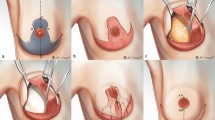Abstract
Background
Breast drooping usually results from two concomitant factors: breast parenchymal involution, which leads to volume loss, altogether with a progressive laxity of the skin envelope which becomes inelastic and flabby (means so loose). The authors propose a double-flap technique which includes transposition of inferiorly based dermoglandular tissue underneath a superiorly based flap to achieve a central projection and upper fullness altogether with raising the inframammary crease.
Methods
From May 2016 to November 2018, 25 patients underwent a double-flap autoaugmentation mammoplasty performed by the authors. Ages ranged from 25 to 45 years. All patients were nonsmokers and had body mass indexes (BMI) of less than 30. The mean follow-up period was 18 months All cases have had grade III breast ptosis with a broad-base, flappy breasts with deficient central projection. All patients aimed at having an augmented, elevated breast without insertion of a silicon implant.
Results
A total of 23 cases showed a significant improvement in breast contour and central projection, with overall satisfaction to both patient and surgeon. Two cases progressed to an implant augmentation subsequent to the mastopexy. One patient had postoperative seroma that were managed with frequent aspirations. The nipple areola complex (NAC) wounds passed smoothly in all cases without any complications regarding the vascularity or wound infection.
Conclusions
The double-flap autoaugmentation mastopexy is a method of breast reshaping that adopts a concept of glandular rearrangement. In properly selected patients with adequate breast volume and moderate skin elasticity, with mild to moderate ptosis, who refuse a prosthetic implant insertion, this procedure safely and adequately restores the youthful conical breast appearance.
Level of evidence: Level IV, therapeutic study.








Similar content being viewed by others
References
Aufricht G (1949) Mammaplasty for pendulous breasts: empiric and geometric planning. Plast Reconstr Surg 4:13–29
Wise RJ (1956) A preliminary report on a method of planning the mammaplasty. Plast Reconstr Surg 17:367–375
Regnault P (1966) The hypoplastic and ptotic breast: a combined operation with prosthetic augmentation. Plast Reconstr Surg 37:31–37
Erol O, Spira M (1980) A mastopexy technique for mild to moderate ptosis. Plast Reconstr Surg 65:603–609
Benelli L (1990) A new periareolar mammaplasty: the “round block” technique. Aesthetic Plast Surg 14:93–100
Peter K, Kenneth K, Casas LA (2010) Superior pedicle autoaugmentation mastopexy: a review of 34 consecutive patients. Aesthetic Surg J 30(2):201–210
Hall-Findlay EJ (2002) Vertical breast reduction with a medially based pedicle. Aesthetic Surg J 22:185–194
Abramo AC, Lucena TW, Sgarbi RG et al (2019) Mastopexy autoaugmentation by using vertical and triangular flaps of mammary parenchyma through a vertical ice cream cone-shaped approach. Aesthetic Plast Surg.
Hammond DC Atlas of aesthetic breast surgery chapter 5, 85–87
Rubin JP (2006) Mastopexy after massive weight loss: dermal suspension and total parenchymal reshaping. Aesthetic Surg J 26:214–222
Gurunluoglu R, Kubek E, Arton J (2013) Dual pedicle mastopexy technique for reorientation of volume and shape after subglandular and submuscular breast implant removal. Eplasty. 13:e48
Araujo Ceraqueira A (1998) Mammoplasty: breast fixation with dermogladular mono upper pedicle flap under the pectoralis muscle. Aesthetic Plast Surg. 22:279–283
Graf R, Biggs TM (2002) In search of better shape in mastopexy and reduction mammoplasty. Plast Reconstr Surg 110:309–317
de la Plaza R, Cruz L, Moreno (2005) Mastopexy utilizing a dermoglandular hammock flap. Aesthetic Surg J 25:31–36
Author information
Authors and Affiliations
Corresponding author
Ethics declarations
Conflict of interests
Ahmed Elnaggar, Rami Makkar and Mohammed Ashraf declare that they have no conflict of interest.
Ethical approval
This study was reviewed and approved by the ethics committee at the Faculty of Medicine, Cairo University.
Patient consent
Verbal and written informed patient consent were obtained.
Funding
The authors received no financial support for the research and authorship of this article.
Additional information
Publisher’s note
Springer Nature remains neutral with regard to jurisdictional claims in published maps and institutional affiliations.
Rights and permissions
About this article
Cite this article
Elnaggar, A., Makkar, R. & Ashraf, M. Autoaugmentation mastopexy using the double-flap technique. Eur J Plast Surg 43, 399–406 (2020). https://doi.org/10.1007/s00238-020-01635-x
Received:
Accepted:
Published:
Issue Date:
DOI: https://doi.org/10.1007/s00238-020-01635-x




